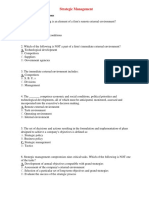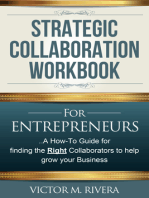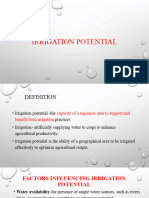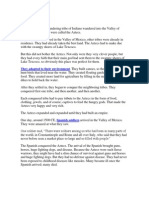0 ratings0% found this document useful (0 votes)
22 viewsStrategic Management One Word
Strategic Management One Word
Uploaded by
SridharanCopyright:
© All Rights Reserved
Available Formats
Download as PDF, TXT or read online from Scribd
Strategic Management One Word
Strategic Management One Word
Uploaded by
Sridharan0 ratings0% found this document useful (0 votes)
22 views7 pagesOriginal Title
strategic management one word
Copyright
© © All Rights Reserved
Available Formats
PDF, TXT or read online from Scribd
Share this document
Did you find this document useful?
Is this content inappropriate?
Copyright:
© All Rights Reserved
Available Formats
Download as PDF, TXT or read online from Scribd
Download as pdf or txt
0 ratings0% found this document useful (0 votes)
22 views7 pagesStrategic Management One Word
Strategic Management One Word
Uploaded by
SridharanCopyright:
© All Rights Reserved
Available Formats
Download as PDF, TXT or read online from Scribd
Download as pdf or txt
You are on page 1of 7
Strategic Management MCQ: Multiple Choice Questions and
Answers on Strategic Management
1. The fundamental purpose for the existence of any organization is
described by its
a. policies
b. mission
c. procedures
d. strategy
2. The fundamental purpose of an organization's mission statement is
to
a. creates a good human relations climate in the organization
b. defines the organization's purpose in society
c. defines the operational structure of the organization
d. generates good public relations for the organization
3. The acronym SWOT stands for
a. Special Weapons for Operations Timeliness
b. Services, Worldwide Optimization, and Transport
c. Strengths Worldwide Overcome Threats
d. Strengths, Weaknesses, Opportunities, and Threats
4. Which of the following is not a characteristic of strategic
management from other types of management?
a. It is interdisciplinary.
b. It has an external focus.
c. It has an internal focus.
d. It concerns the present direction of the organization.
5. Which of the following is an issue considered in developing
corporate strategies?
a. What businesses) are we in?
b. What direction are we going?
c. What resources do we have to implement our strategies?
d. What businesses are we in and what to do with those businesses?
6. Which of the following is NOT a major element of the strategic
management
a. Formulating strategy
b. Implementing strategy
c. Evaluating strategy
c. Assigning administrative tasks
7. Competitive advantage can best be described as:
a. increased efficiency.
b. what sets an organization apart.
c. a strength of the organization.
d. intangible resources.
8. is the foundation of blue ocean strategy
a. Innovation
is the foundation of blue ocean strategy.
b. Value creation
c. Value innovation
d. value cost trade-off
9. The various organizational routines and processes that determine
how efficiently and effectively the organization transforms its inputs
into outputs are called:
a. strengths.
b. core competencies.
c. capabilities.
d. customer value.
10. When defining strategic management, the most important thing to
remember is that it is:
a. Not as easy as you think
b. Mainly the province of senior managers
c. A living evolving process
d. More conceptual than practical
11. An organisation's strategy:
a. remains set in place longer than the mission and objectives
b. generally forms over a period of time as events unfold
c. tends to be formed at the same time the mission is developed and
objectives are formulated
d. is usually conceived at a single time when managers sit down and
work out a comprehensive strategic plan for the next 3-5 years
12. The primary focus of strategic management is:
a. strategic analysis
b. the total organisation
c. strategy formulation
d. strategy implementation.
13. Which of the following is not an advantage of strategic
management?
a. It provides organisations with a clearer sense of direction and
purpose
b. It helps improve the political, economic, social and technological
environment of the organisation
c. It helps orientate management decisions to relevant environmental
conditions
d. It helps organisations be proactive rather than reactive
14. Which of the following defines what business or businesses the firm
is in or should be in?
a. Business strategy
b. Corporate strategy
c. Functional strategy
d. National strategy
15.Which of the following defines how each individual business unit
will attempt to achieve its mission?
a. Business strategy
b. Corporate strategy
c. Functional strategy
d. National strategy
16. Which of the following focuses on supporting the corporate and
business strategies?
a. Competitive strategy
b. Corporate strategy
c. Operational strategy
d. National strategy
17. Which one of the following is not a primary task of strategic
managers?
a. Establishing strategic objectives
b. Developing the steps to follow in implementing operation level
plan
c. Defining the business and developing a mission
d. Developing a strategy
18. The task of strategy choice involves:
a. developing plans and activities which will improve the
organisation's performance and competitive position
b. determining how the organisation can be more market and efficiency
oriented
c. monitoring whether the organisation is achieving good financial
performance
d. keeping the organisation free of debt
19. Which one of the following is at the core of strategic management?
a. Choosing which organisational objectives to focus on
b. Being alert for opportunities to change work responsibilities
c. Adapting the organisation to a changing external environment
d. Choosing whether to make decisions autocratically or on the basis of
participation
20. The corporate level is where top management directs:
a. all employees for orientation
b. its efforts to stabilize recruitment needs
c. overall strategy for the entire organization
d. overall sales projections
21. The three organizational levels are:
a. corporate level, business level, functional level
b. corporate level, business unit level, functional level
c. corporate strategy level, business unit level, functional level
d. corporate strategy level, business level, specialist level
22. Which of the following is an example of competing on quick
response?
a. a firm produces its product with less raw material waste than its
competitors
b. a firm offers more reliable products than its competitors
c. a firm's products are introduced into the market faster than its
competitors'
d. a firm's research and development department generate many ideas
for new products
23. Which one of the following is NOT included in the Porter's Five
Forces model:
a. Potential development of substitute products
b. Bargaining power of suppliers
c. Rivalry among stockholders
d. Rivalry among competing firms
24. What is meant by the term 'Stakeholder'?
a. A person who is not related with a business.
b. A person who is related with a business.
c. A person who owns a business.
d. A person who purchases the shares of a business.
25. Of the following, which one would NOT be considered one of the
components of a mission statement?
a. The target market for XYZ is oil and gas producers as well as
producers of chemicals.
b. XYZ shall hire only those individuals who have with sufficient
educational levels so as to be of benefit to our customers
c. The customers of XYZ shall include global and local consumers of
gas and oil products and
You might also like
- Viva Ems Gr. 7 Lesson Plans Term 3 Week 1 10Document22 pagesViva Ems Gr. 7 Lesson Plans Term 3 Week 1 10Portia Mudalahothe90% (39)
- Multiple Choice QuestionsDocument33 pagesMultiple Choice Questionsamit100% (6)
- QCM Corporate Strategy 2Document85 pagesQCM Corporate Strategy 2rupok100% (2)
- Chapter 01Document5 pagesChapter 01Alima Toon Noor Ridita 1612638630No ratings yet
- Release, Waiver, Quitclaim Agreement: - (PHP - ) Which Is in Full and FinalDocument2 pagesRelease, Waiver, Quitclaim Agreement: - (PHP - ) Which Is in Full and FinalBam Santos100% (2)
- Strategic Management (STRA701) - Semester IIIDocument19 pagesStrategic Management (STRA701) - Semester IIIVishal Bhan100% (1)
- Organization and Management Answer KeyDocument6 pagesOrganization and Management Answer KeyLala Bora100% (6)
- SHRM MCQ PDFDocument11 pagesSHRM MCQ PDFneha100% (3)
- MCQ - SMDocument105 pagesMCQ - SMbhaumik patelNo ratings yet
- Strategic Management Objective QuestionsDocument70 pagesStrategic Management Objective QuestionsJose Sebastian50% (2)
- Attendee List 10-27-14Document8 pagesAttendee List 10-27-14henryhayesNo ratings yet
- Strategic MGT Mid QPDocument8 pagesStrategic MGT Mid QPK MaheshNo ratings yet
- Management MCQDocument20 pagesManagement MCQRabiaSaleemNo ratings yet
- FOS - Sample QuestionsDocument12 pagesFOS - Sample QuestionsDeblina SaharoyNo ratings yet
- 2 Sem Advanced Strategic ManagementDocument20 pages2 Sem Advanced Strategic Managementsruthi kjNo ratings yet
- 300+ TOP Strategic Management MCQs and Answers 2021 - 1630772242060Document35 pages300+ TOP Strategic Management MCQs and Answers 2021 - 1630772242060Curt CobbtNo ratings yet
- A. Strategies: Strategic Management Test 3 Jan 2022 by SNPDocument6 pagesA. Strategies: Strategic Management Test 3 Jan 2022 by SNPNewfangled VibesNo ratings yet
- CT-2 SM 2021Document5 pagesCT-2 SM 2021Incredible video'sNo ratings yet
- Stategies ManaDocument23 pagesStategies ManaHuy Ha HoangNo ratings yet
- Corporate Strategy MCQDocument38 pagesCorporate Strategy MCQFakeha ShahidNo ratings yet
- Quiz I - Intro To STR MGMTDocument5 pagesQuiz I - Intro To STR MGMTSuraj Sapkota100% (1)
- BP&S Quiz AssignmentDocument5 pagesBP&S Quiz AssignmentPrashansa khadkaNo ratings yet
- SM Multiple Choice 1Document6 pagesSM Multiple Choice 1Tú Anh NguyễnNo ratings yet
- Midterm Study Questions - MGT 301 J 06 J 02 J 01 J October 17 J-2023Document8 pagesMidterm Study Questions - MGT 301 J 06 J 02 J 01 J October 17 J-2023qypctpnbp8No ratings yet
- Advanced Strategic Management (Set 1)Document22 pagesAdvanced Strategic Management (Set 1)devanshtyagi316No ratings yet
- QTCLDocument9 pagesQTCLtruongson123No ratings yet
- Startegic Management MCQsDocument18 pagesStartegic Management MCQsMuqaddas ZulfiqarNo ratings yet
- Strategic Management Multiple Choice Questions Strategic Management Multiple Choice QuestionsDocument25 pagesStrategic Management Multiple Choice Questions Strategic Management Multiple Choice QuestionsYogesh SabaleNo ratings yet
- Chapter 13 Business Policy and Formulation of Functional StrategyDocument19 pagesChapter 13 Business Policy and Formulation of Functional StrategyvarunkhalasNo ratings yet
- Semas Handout 1 Part 1Document3 pagesSemas Handout 1 Part 1GONZALES, MICA ANGEL A.No ratings yet
- Paper Strategic ManagementDocument22 pagesPaper Strategic ManagementFaheem Jutt0% (1)
- Stratman Accounting Multiple Choice 2023Document25 pagesStratman Accounting Multiple Choice 2023Primrose ChisungaNo ratings yet
- MCQ Questions On StrategyDocument9 pagesMCQ Questions On Strategyy100% (2)
- Advanced Strategic Management Solved MCQs (Set-1)Document6 pagesAdvanced Strategic Management Solved MCQs (Set-1)Wubie Bantie100% (2)
- Strategic ManagementDocument17 pagesStrategic Managementfuture trade100% (1)
- Strategic Management Final Test Multiple Choice QuestionDocument4 pagesStrategic Management Final Test Multiple Choice QuestionHUONG PHAM THI LANNo ratings yet
- FBA411 Test Qs Compiled by AccountricianDocument9 pagesFBA411 Test Qs Compiled by Accountricianbabatundeahmed69No ratings yet
- SM-Mid Exam BestDocument4 pagesSM-Mid Exam BestmishamomanedoNo ratings yet
- Strama Chapter 1 Test BankDocument11 pagesStrama Chapter 1 Test BankCookie Pookie BallerShopNo ratings yet
- Chapter 1 QuizDocument5 pagesChapter 1 QuizOWEN TOLINNo ratings yet
- Business Policy and Strategic Management PDFDocument23 pagesBusiness Policy and Strategic Management PDFPurnesh Jagad100% (1)
- Strategic Management Mcqs Unit 1Document15 pagesStrategic Management Mcqs Unit 1Hemant Kumar AhirwarNo ratings yet
- MCQ-Strategic - Advanced HRMDocument8 pagesMCQ-Strategic - Advanced HRMVamshi KrishnaNo ratings yet
- Strategic Planning and Marketting Segmentation McqsDocument5 pagesStrategic Planning and Marketting Segmentation McqsHaritha HaribabuNo ratings yet
- Chapter 12 Introduction To Strategic ManagementDocument25 pagesChapter 12 Introduction To Strategic Managementluckyagarwal.ra56No ratings yet
- Strategic MGT PascoDocument8 pagesStrategic MGT Pascoobengm418No ratings yet
- 1634554599ca Inter SM MCQ 1Document102 pages1634554599ca Inter SM MCQ 1Nithish OfficialNo ratings yet
- Strategic Management MCQ: Multiple Choice Questions and Answers On Strategic ManagementDocument50 pagesStrategic Management MCQ: Multiple Choice Questions and Answers On Strategic ManagementSharanReddyNo ratings yet
- Principle of ManagementsDocument77 pagesPrinciple of ManagementsJayson LucenaNo ratings yet
- Summatest Series 1-100 - Entrep12 - Christmas Break SY 2023-2024 - No KeysDocument14 pagesSummatest Series 1-100 - Entrep12 - Christmas Break SY 2023-2024 - No KeyspaladmarcelonoNo ratings yet
- Strategic Management: 2 Quiz Roll No.Document5 pagesStrategic Management: 2 Quiz Roll No.Hira Raza100% (1)
- Chap2 MC Questions&AnswersDocument9 pagesChap2 MC Questions&AnswersAfsana ParveenNo ratings yet
- Strategic MGMT MCQs - End TermDocument10 pagesStrategic MGMT MCQs - End TermVineesha GurnaniNo ratings yet
- Muhammad Bilal F2020052025 Midterm ExamDocument5 pagesMuhammad Bilal F2020052025 Midterm ExamMuneeb AhmadNo ratings yet
- (Chapter 1) - Basic Concepts of Strategic ManagementDocument7 pages(Chapter 1) - Basic Concepts of Strategic ManagementNguyễn HiếuNo ratings yet
- 1st Quiz - Feb 24, 2021Document4 pages1st Quiz - Feb 24, 2021Hira RazaNo ratings yet
- MGT603 100% Sure Mid MCQs (85) by Aniqa MalikDocument13 pagesMGT603 100% Sure Mid MCQs (85) by Aniqa MalikHamzaNo ratings yet
- Execution Excellence: Making Strategy Work Using the Balanced ScorecardFrom EverandExecution Excellence: Making Strategy Work Using the Balanced ScorecardRating: 4 out of 5 stars4/5 (1)
- Strategic Management: Formulate and Implement Strategies, Analyze the Competitive Environment and Make Strategic Decisions: Administration: The science of managing resourcesFrom EverandStrategic Management: Formulate and Implement Strategies, Analyze the Competitive Environment and Make Strategic Decisions: Administration: The science of managing resourcesNo ratings yet
- Indian Income Tax Return Assessment Year 2021 - 22: SugamDocument12 pagesIndian Income Tax Return Assessment Year 2021 - 22: SugamArihant SatpathyNo ratings yet
- Ayuda 2.1. Countable and Uncountable Nouns With QuantifiersDocument21 pagesAyuda 2.1. Countable and Uncountable Nouns With QuantifiersSilvana YogaNo ratings yet
- Hilton 11e Chap007PPT-STUDocument52 pagesHilton 11e Chap007PPT-STUNgọc ĐỗNo ratings yet
- Mard Noun ClauseDocument9 pagesMard Noun ClauseM P SinagaNo ratings yet
- Statsbook FE2013 PDFDocument114 pagesStatsbook FE2013 PDFFirdaus TahirNo ratings yet
- Brandy by Yutik and Mohit, Batch - 2018 To 2121Document13 pagesBrandy by Yutik and Mohit, Batch - 2018 To 2121shouvik ghatakNo ratings yet
- Marketing Cost and Profitability AnalysisDocument10 pagesMarketing Cost and Profitability AnalysisBharathi RajuNo ratings yet
- 1200 25 TunnelingDocument9 pages1200 25 TunnelingamitkuknaNo ratings yet
- Taste The FeelingDocument2 pagesTaste The FeelingSaagar HiRaNo ratings yet
- Suite 3 Suite 4: Suite 1 & 2 Blow-Up Plan 1 Suite 3 & 4 Blow-Up Plan 3Document1 pageSuite 3 Suite 4: Suite 1 & 2 Blow-Up Plan 1 Suite 3 & 4 Blow-Up Plan 3Stephany JulaoNo ratings yet
- Kongsberg - 008 Annex B - Integrated Logistic SupportDocument18 pagesKongsberg - 008 Annex B - Integrated Logistic Supportkaiser777No ratings yet
- WWWRPG Gimmicks Color April2016Document20 pagesWWWRPG Gimmicks Color April2016Luis Júpiter Franco MartínezNo ratings yet
- Life in Modern BritainDocument18 pagesLife in Modern Britainihasyou PlayzNo ratings yet
- Regulasi Penanganan Kejaha Tan Siber DilingkungantniangkatandaratDocument254 pagesRegulasi Penanganan Kejaha Tan Siber Dilingkungantniangkatandaratclasmild22No ratings yet
- Chapter 10Document23 pagesChapter 10Samit ShresthaNo ratings yet
- Distribution Plan 22.05.2022 - Schedule No.1 PDFDocument24 pagesDistribution Plan 22.05.2022 - Schedule No.1 PDFShamika Ishan KumanayakaNo ratings yet
- de thi tiếng anh lớp 8Document5 pagesde thi tiếng anh lớp 8nguyenhongg1501No ratings yet
- Chroma™ Talent Management: Platform SolutionsDocument7 pagesChroma™ Talent Management: Platform SolutionsRutuja ChougaleNo ratings yet
- Tea StartupDocument7 pagesTea StartupDattatray GosaviNo ratings yet
- INFS5000 Skills MatrixDocument5 pagesINFS5000 Skills MatrixhaipeiNo ratings yet
- Irrigation PotentialDocument11 pagesIrrigation PotentialLav VickyNo ratings yet
- Bill of Rights 1689 ClassDocument17 pagesBill of Rights 1689 ClassDavid Rodriguez FernandezNo ratings yet
- Aztec Empire: They Adapted To Their EnvironmentDocument11 pagesAztec Empire: They Adapted To Their EnvironmentAdrián Durán AguilarNo ratings yet
- Descriptive EssayDocument2 pagesDescriptive EssayZobia Rafiq Bhadelia50% (2)
- Procedures and Functions of Civil and Military Contiones in RomeDocument14 pagesProcedures and Functions of Civil and Military Contiones in RomeRubenNo ratings yet
- Invoice: Page 1 of 2Document2 pagesInvoice: Page 1 of 2Janakiram YarlagaddaNo ratings yet
- Soal Pas B. Inggris KLS Xii Semester Ganjil SMKDocument6 pagesSoal Pas B. Inggris KLS Xii Semester Ganjil SMKWulandari Agung MaEzraNo ratings yet

























































































